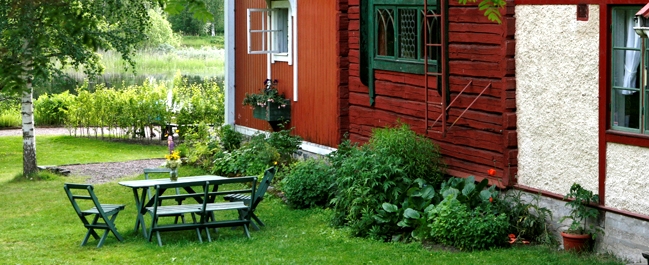IN PREVIOUS ENTRIES, I discussed the influence of sterile modern design on the home. In a series of intermittent posts, I will be offering some basic principles of interior decorating for traditionalists. Here is Principle Number One. 
I. DEFLECT THE EYE FROM UGLINESS.
Traditional homes, in an age when the model of the two-income family reigns, have one big problem. Let’s call it fundlessness. Adhering to the absolute necessity of a woman at home, the traditional family may live in a state of genteel poverty or, even worse, serious impecuniousness. Forced by this condition to buy a small, hideous house or rent a small, hideous apartment, traditionalists face a seemingly insurmountable foe: ugliness.
The one-income family is much more likely to encounter architectural oppression than its relatively high-flying two-income counterpart. This oppression may appear in the form of a rectangular 1950s ranch house with metal windows and asbestos flooring; a tiny, dormered Cape Cod with rooms no bigger than horse stalls, or a “garden” apartment complex that has all the charm of a Stalingrad high-rise. There’s no point in pretending you live in a castle when you live in a shoebox. It is of absolute importance to acknowledge ugliness in one’s immediate surroundings. Denying it will only make things worse. Once a person reckons with the existence of a demon, he can begin to exorcise it.
And, that’s what interior decorating becomes in these unfortunate cases: a form of exorcism. One cannot knock down walls; erect additions that will obscure the original outlines of the house; or blast the whole thing to smithereens. One has to work within the body one has been given.
Do not despair. The human eye craves beauty. It is easily distracted from ugliness whenever there is the slightest sign of true beauty in a room. The trick is to purge the demon by your own process of embellishment. This is not always easy and takes some careful thought and consideration. Women who come into an ugly house and immediately festoon it with stencilled flowers in an effort to mask cheap architecture only make things worse. You must first examine the ugliness, breathe it in, look for the breaches in its defenses. Do nothing until you have taken stock of the enemy. This may take months or, depending on the formidability of the foe, even years.
Once one has studied the enemy, one can come up with simple strategies. Find the ugliest point in a room and work to move the eye away from it. Initially, it may be things no more expensive than a few house plants, a beautiful table cloth, or a collection of sea shells gathered at the shore to begin the process. Later, one can work with paint, furniture, fabric, lamp fixtures and art objects, all within whatever budget you are given, to lend your shoebox charm. There is no home that is irretrievably ugly. None. The very cheapest of homes can indeed be made into a castle with patience and perseverance.
I once met a woman who lived on the edge of a four-lane highway. Her tiny ranch house was the sole remnant of a vanished neighborhood that had been knocked down to make room for strip malls. To make things worse, her house was not originally lovely. Surrounded by hideousness all around, embedded in the very heart of the demon, she had created a home filled with feminine delightfulness. It was not possible to point to one little knick knack in her collection or one piece of furniture that was responsible for the pervasive atmosphere of charm and repose. It was a mysterious almagamation of effects, all of them very cheap.
This woman had come into the heart of the beast. She had seen. And she had conquered.
 Country Living Magazine
Country Living Magazine
Read More »






 Country Living Magazine
Country Living Magazine![[Boutibonne_Charles_Edouard_Mountain_Climbersb1816-1897.jpg]](https://3.bp.blogspot.com/_R9JwdOLpUMw/SudjtLftlEI/AAAAAAAAF5E/ubGMzyGlmPo/s1600/Boutibonne_Charles_Edouard_Mountain_Climbersb1816-1897.jpg)




